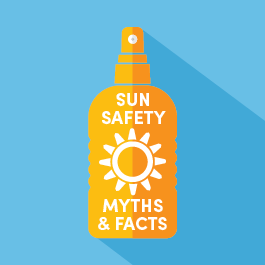Myth: Sunscreen provides enough sun protection
Fact: Sunscreen doesn’t provide enough sun protection for your skin. It’s important to use broadspectrum SPF 30 or higher sunscreen because it filters ultraviolet radiation (UVR) and protects you from reflected UVR from surfaces like water, sand and concrete. Sunscreen wears off and needs to be reapplied every 2 hours.
However, sunscreen is not a suit of armour and should be used with the other ways of protecting yourself.

Myth: Skin cancer is a less serious form of cancer because it can easily be cut out
Fact: Skin cancer is very serious, and treatment isn’t always as easy as removing a mole.
Melanoma is the most dangerous form of skin cancer. It can travel to other parts of your body, making it difficult to treat.
Know your skin, check it regularly and talk to your doctor about any concerns.
Myth: Skin cancer only affects fair-skinned people
Fact: Skin cancer affects people with all skin types. Did you know Bob Marley (a Jamaican singer) died from an untreated melanoma that spread to his brain?
Skin cancer is less common in people with darker skin, but it is often found at a more advanced stage.
Myth: Skin cancer is caused by sunburn
Fact: You don’t need to get sunburnt to develop skin cancer. Skin cancer occurs when skin cells are damaged, from over exposure to UVR from the sun.
We’re exposed to UVR every time we go outdoors, and even short sun exposure adds up over time to skin damage.
Sunburn increases your risk even more because the damage to the skin cells can be more severe.
Myth: You only need sun protection on hot, sunny days
Fact: You need to use sun protection methods every day. It doesn’t matter if it’s sunny, cloudy, or raining—UVR is always there during daylight. So in Queensland you need to protect yourself in 5 ways every day.
Myth: Tanning lotions and spray tans protect your skin from UVR
Fact: Fake tanning lotions and spray tans don’t protect your skin from UVR because they do not contain sun protection factor (SPF).
If you have a fake tan, you still need to protect yourself in 5 ways whenever you are outside.
Myth: You need sun exposure for vitamin D
Fact: It’s unsafe to seek extra sun to top-up vitamin D levels. Spending extra time in the sun will not increase vitamin D levels – but it will increase your risk of skin cancer. Most people get enough UV exposure to maintain vitamin D levels through their usual outdoor activities. Using sun protection including sunscreen does not stop your body generating vitamin D.
Talk to your doctor if you’re concerned about your vitamin D level.
https://www.qld.gov.au/health/staying-healthy/environmental/sun/facts
Date published: 18 Jul 202


